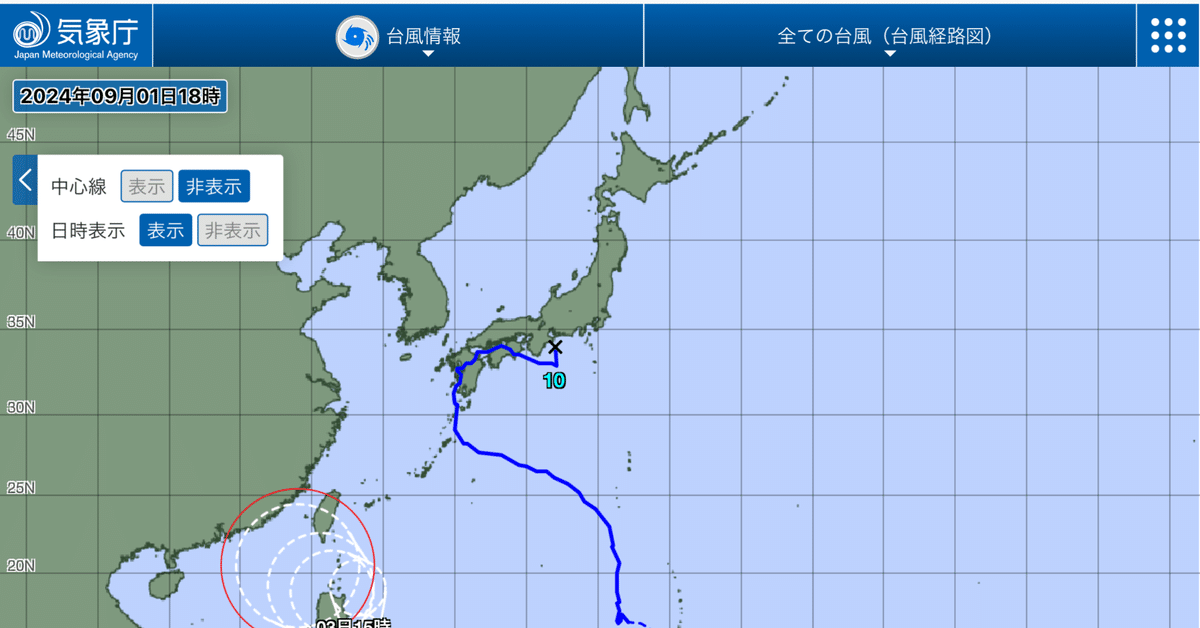
台風10号の軌跡:2024年9月3日(火)
奇しくも,さきの台風10号(サンサン)の軌跡をみると(上の写真,気象庁Webページから抜粋),南海トラフ想定地域と重なって見えるのが,実に腹立たしい。ただし,これらが重なる科学的根拠は今のところない。
もはや,日本にとって,気候変動問題は他人事ではない。台風10号は,温暖化が進む日本に今後やってくる「台風の姿」の予兆を示しているような気がする。日本が温帯から亜熱帯(熱帯)に変わると,台風による影響も変わり,これまでとは異なる「台風の姿」を認識しなければならないのかもしれない。
台風10号は,2024年8月22日午前3時にマリアナ諸島で発生し,その後,毎日更新される気象庁公表の予想進路を見事に外し続けながら,8月29日午前8時頃に鹿児島県薩摩川内市内に上陸し,ゆっくりと日本列島を横断して,9月1日正午に東海道沖で熱帯低気圧となった。台風10号は,10日間と9時間の間,日本に接近・上陸・移動して,線状降水帯,ゲリラ雷雨,遠隔豪雨,突風,大雨暴風による洪水浸水・土砂災害・人的被害・建造物被害・農作物被害・社会経済活動の変更停止に伴うさまざまな損失を与えた。
今後も「異なる姿の台風」によって頻繁に起きるであろう新幹線・鉄道・道路輸送の問題については,計画運休や計画的な通行止め等の有効的な運用,および代替的な輸送移動手段の確保を中心に,国・地方自治体レベルと企業レベルでの方策対応の検討が早急に必要である。
重要な視点は,①台風の進路が複雑性を増していることと,②台風が持たらす暴風雨による影響の中身がこれまでと異なること,を分けて考える必要があることである。
日本の国土強靭化のためには,耐震性確保とインフラ老朽化対策は全国共通の問題であるが,河川の氾濫防御や土砂災害対策等はこれまでは想定対象外であった地域も厳しく対応していくことが求められる。


The Path of Typhoon No. 10: Tuesday, September 3, 2024
Ironically, when we look at the path of Typhoon No. 10 (Shanshan, see the photo above, excerpted from the Japan Meteorological Agency's website), it overlaps with the anticipated Nankai Trough region, which is truly frustrating. However, there is currently no scientific evidence to support this overlap.
The issue of climate change is no longer someone else's problem for Japan. Typhoon No. 10 seems to hint at the future "form of typhoons" that will come to a warming Japan. As Japan transitions from a temperate to a subtropical (or tropical) climate, the impact of typhoons will also change, and we may need to recognize a "different form of typhoon" than we've seen before.
Typhoon No. 10 formed in the Mariana Islands at 3:00 AM on August 22, 2024. Despite consistently defying the predicted path released daily by the Japan Meteorological Agency, it made landfall in Satsumasendai City, Kagoshima Prefecture, around 8:00 AM on August 29. The typhoon then slowly traversed the Japanese archipelago, eventually becoming a tropical depression off the coast of the Tōkaidō region at noon on September 1. Over the course of 10 days and 9 hours, Typhoon No. 10 approached, made landfall, and moved across Japan, causing a wide range of damage due to linear rainbands, sudden downpours, remote heavy rainfall, gusty winds, and torrential rainstorms. This resulted in flooding, landslides, human casualties, damage to buildings and crops, and various losses due to disruptions in social and economic activities.
Regarding the issues with Shinkansen, railways, and road transportation that are likely to occur frequently due to future "typhoons of different nature," it is urgently necessary to consider effective measures at both the national and local government levels, as well as at the corporate level. These measures should focus on the efficient implementation of planned suspensions and road closures, as well as securing alternative transportation options.
The important perspective here is to separately consider (1) the increasing complexity of typhoon paths, and (2) the differences in the nature of the impacts caused by typhoons' heavy rain and strong winds compared to before.
For the resilience of Japan's national land, securing earthquake resistance and addressing infrastructure aging are common issues nationwide. However, regions that were previously considered outside the scope of measures will now be required to rigorously address issues such as river flood defenses and landslide disaster prevention.
